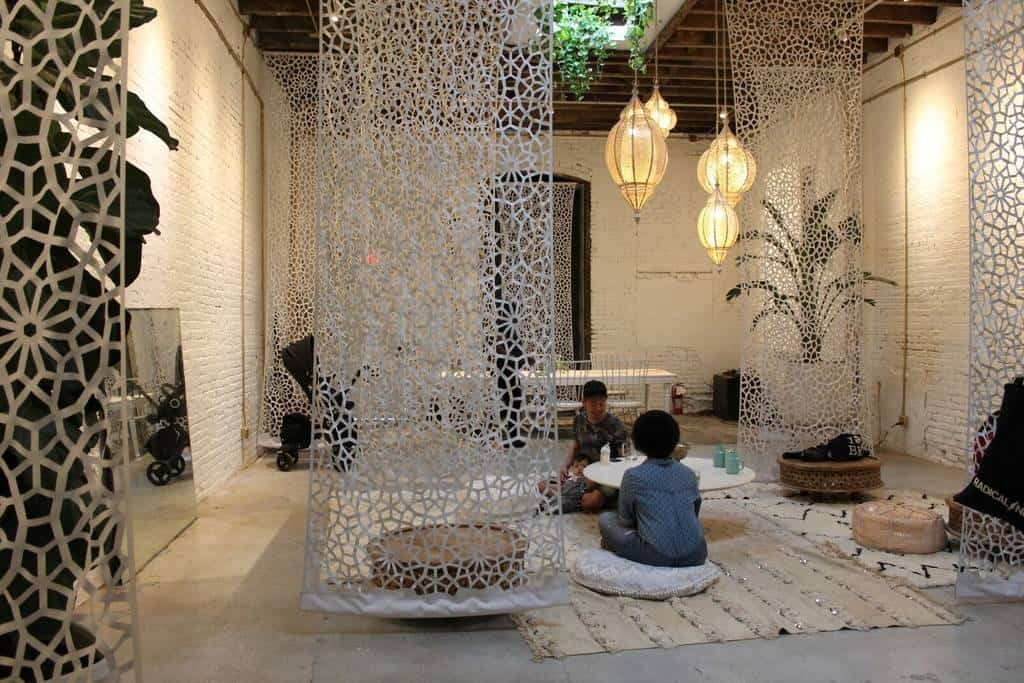Last year, in June, Ashley Taylor and Cayla Huppert leased a 2,500-square-foot disused warehouse at 22 Commerce Street. Taylor and her fiancé, the designer Tymer Tilton, refurbished the interior, which now operates as an upscale event space for birthday parties, baby showers, bar mitzvahs, and photo shoots. Amenities include a 15,000-watt QSC sound system, a projector and screen, a fog machine, and security upon request. Dubbed RE:GEN:CY, it rents for $175 an hour, with a minimum fee of $1,250 on Fridays and Saturdays. An upstairs recording studio rents for $35 an hour.
RE:GEN:CY also functions as the headquarters for a more complicated endeavor called the Regenerative Resource Network (RRN), an experimental enterprise founded by Taylor and Huppert with an aim “to promote sustainable growth through localism, a belief that people living in a community are better at making decisions that affect them rather than outside parties.” RRN intends to “bring together people, projects, resources, and ideas about how to improve local support networks and help communities become more self-sufficient, equal, and diverse.” For this purpose, RE:GEN:CY will use funds from the abovementioned parties and photo shoots to host public talks and workshops to facilitate the inclusive, democratic development of projects and technologies that, ideally, will help transform Red Hook.
Blockchain specialist
On her Twitter profile, Taylor, age 27, describes herself as a “regenerative systems designer inserting long term perspective into digital infrastructure focusing on blockchain.” Blockchain is the public ledger that records cryptocurrency transactions.
A Red Hook resident for the past two years, Taylor grew up in hilly, small-town North Carolina and, after graduating from Duke University with a degree in cultural anthropology and visual and media studies, found work as a studio manager for data visualization artists at the Office for Creative Research in Downtown Brooklyn. Here, Taylor, whose father had worked in local government in her hometown, “started to get interested in technology, because I was realizing that a lot of the ways people were designing digital infrastructure was for profit and not taking into account what were local community development ideas.”
Her own ideas evolved at a subsequent think tank job at the Center for Planetary Culture, where she discovered the concept of alternative currencies. “We must make a rapid shift from a debt-based financial system that forces constant growth to a regenerative economy, based on cooperation, sharing of resources, [and] peer-to peer production, where value is linked to the health of communities and the restoration of ecosystems,” she wrote in 2014. “An alternative economic system would provide an ecosystem of tools for particular purposes, rather than a monoculture where value is controlled by a single monopoly or cartel. It would include a number of instruments for exchanging value that support different behavior patterns and beliefs.”
Taylor liked, for instance, the notion (as she put it last month) of “a time bank, where the units of account, instead of being a dollar bill, are time. So if you had one in Red Hook, people are contributing to go clean up the pier, and they’re earning credits, and they can spend those in other ways. That idea was interesting, and that obviously led me to the Bitcoin and cryptocurrency movement that was going on.”
When the think tank dissolved, she went to work for a new company, ConsenSys, whose platform, called Ethereum, “was building upon the idea of Bitcoin, which is creating a money that can be sent around with a particular rule of how the currency is created and particular rules about how the currency can be traded,” she explained. “Ethereum was trying to take that idea and then make it into a programming language, so that you could create a bunch of rules about how money or resources or whatever you want to call them – digital assets – can be moved around, and there was a lot of talk about how that could, for example, automate cooperative companies.”
Blockchain for community
She put forth a hypothetical case. “If everyone in Red Hook had a local power grid, and we want to set up this entity that manages it, then what are we going to let ownership look like? Are we just going to let anybody buy in, and the richest people get the biggest portion of the ownership, which oftentimes is how capital functions today? Or are we going to create different rules? … An alternative way would be, if you have lower income, then the money you invest is worth more. That’s an alternative way to structure this. … And then that conversation gets programmed into the bylaws of this entity.” At ConsenSys, she “was interested in digitally updating the ways people organize, so instead of having to have a complicated process of submitting the shares of ownership [for a communally owned good] to be managed by some other entity developing the technology,” a community could do it on its own.
Taylor worked for ConsenSys for two years, during which she “started doing some research with a group of farming community activists in Upstate New York in Sullivan County, and there were some local meetings that people were having to talk about issues that people were having in the county, and we were saying, ‘Hey, there’s this new technology around. What do you think of this technology?’” Taylor’s concern that “technological development doesn’t normally take into account” the needs of farmers had prompted her attempt, in this case, to solicit ideas from them directly. But she soon “realized that the cryptocurrency company I was part of was more interested in owning the data and making a profit off of it than they were in actually creating something innovative,” so she quit. Well before the Bitcoin crash, Taylor had become “super critical of a lot of stuff that was going on in the cryptocurrency space.”
Underemployment led her to rent out her apartment at the Monarch Luggage Factory, which she and Tilton had decorated in a “funky way,” for photo shoots. This turned into the business model for RE:GEN:CY, which she built with Huppert, a financial analyst at Citigroup. Taylor manages the event space. “As Cayla and I started to discuss what kind of business we would create to address issues that were more abstract, physical space seemed like a way that we could get the ball rolling on a lot of projects,” she recounted, “because we could start this process of educating people that live in a community about some of these ideas we have, and seeing what interest there was – and also seeing, well, are the things that we’re thinking about actually true?”
Red Hook was the perfect spot because “there’s a higher proportion of people that are interested [in localism] than in other places,” owing to its geographic isolation. And thanks to Hurricane Sandy, residents are eager to build transformational projects and embrace the fight against climate change. To learn more about the community, Taylor reached out to neighborhood leaders like Samora Coles of the Alex House Project, Karen Blondel of the Fifth Avenue Committee, and Tiffiney Davis of the Red Hook Art Project (RHAP).
Taylor emphasized that RRN would rather promote conversation than implement unilateral solutions. “We don’t have a grand plan,” she admitted.

So far, RE:GEN:CY has donated space to a number of nonprofits, including the Red Hook Community Justice Center (for its Peacekeepers graduation) and the aforementioned RHAP (for a game night) and Alex House Project (for an end-of-year party). RRN itself may or may not switch someday to nonprofit status, where grants and donations would fund its community development endeavors. “It’s not our intention to always be a rental event space,” Taylor said. Another possibility, however, is to focus on “impact investing” to produce revenue: “If we could figure out how to invest in some businesses we really believe in, that’s another way that we could make money.”
February events
Over the course of four weekends in February and March, RE:GEN:CY will hold a small business growth and development workshop. According to the application, the “workshop will help participants design a plan for sustainable growth and assist with taking their business to the next level. Potential for financing is evaluated on a case by case basis. Cost for participation is free if you attend all 4 sessions.”
Also, on February 8, RE:GEN:CY will host a public presentation by Resilient Red Hook (RRH) about the possibility of building a solar microgrid for the community, which RRN could help to organize and finance. Per RRH, microgrids are “local energy networks that are able to separate from the larger electrical grid during extreme weather events or emergencies, providing power to individual customers and crucial public services.” Similar events are likely to follow at RE:GEN:CY if Red Hook residents prove interested.









